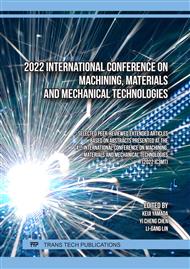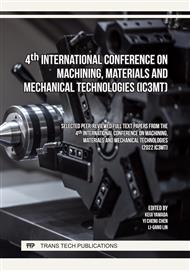[1]
T. Kato, et al., Rotation Control of Air Turbine Spindle using High Precision, Quick Response Pneumatic Pressure Regulator. JFPS International Journal of Fluid Power System Vol. 7, No. 1 pp.9-15 (2012)
DOI: 10.5739/jfpsij.7.9
Google Scholar
[2]
Y. Okamoto, Study on Tool Wear In-Process Estimation for Ball End Mill Using Rotation Control Air Turbine Spindle. JSPE Kyushu Branch 2015 Student Research Association, p.137
DOI: 10.4028/www.scientific.net/kem.749.94
Google Scholar
[3]
N. Osada, et al., Small-diameter end mill processing by rotational control air turbine spindle. In: Proceedings of JSPE 2014 annual meeting, p.24 (in Japanese)
Google Scholar
[4]
O. Tatsuki, et al., Study on tool wear estimation for small diameter ball end mill milling. In: proceedings of IC3MT 059 (2016)
Google Scholar
[5]
O. Tukamoto, et al., Study on processing of high hardness material using rotation control air turbine spindle. In: Proceedings of JSPE Kyusyu Branch Office 2013, p.124 (in Japanese)
Google Scholar
[6]
K. Uehara, et al., In-Process Measurement of the Flank Wear of Cutting Tools. Soc. Prec. Eng. Vol. 39, No. 8 (1973), pp.825-829. (in Japanese)
Google Scholar
[7]
T. Masuzawa, K. Takamasu, Forefront of Micro-hole Machining and Measurement. In: Journal of the Japan Society of Precision Engineering Vol. 78, No. 6 (2012)
DOI: 10.2493/jjspe.78.443
Google Scholar
[8]
O. Okubo, et al., A Study on the Cutting Tool Breakage and Its Prediction in Micro Hole Drilling. In: Transactions of the Japan Society of Mechanical Engineers. Series C Vol.51, No. 471 pp.2929-2935.
DOI: 10.1299/kikaic.51.2929
Google Scholar
[9]
H. Yoshimura, et al., Study on effect of drilling rotational speed and tool wear on chip evacuation of micro drilling of printed circuit board. In: Transactions of the JSME, Vol. 82, No. 834 (2016) (in Japanese)
DOI: 10.1299/transjsme.15-00463
Google Scholar
[10]
T. Sato, et al., Drilling behavior of run-out micro drill (Effect of cutting-edge orientation on centripetal characteristics), In: Journal of the Japan Society for Abrasive Technology, Vol. 58, No. 7 (2014), pp.451-456 (in Japanese)
Google Scholar



